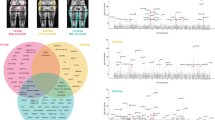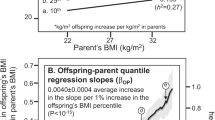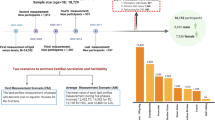Abstract
OBJECTIVES: Abdominal visceral fat (AVF) is considered a risk factor for diabetes, atherogenic lipid profiles and hypertension. However, little is known about the genetic contribution to AVF as compared to total body fat. DESIGN: AVF was assessed by computerized tomography, and total body fat (fat mass) was assessed by underwater weighing in 86 families participating in the Heritage Family Study. All family members were sedentary at baseline examination. The familial factors underlying the variability in age-adjusted AVF, age-fat mass-adjusted AVF and age-adjusted fat mass, were assessed using a familial correlation model. RESULTS: The maximal heritability (including genetic and familial environmental effects) for AVF was comparable before (47%) and after (48%) adjusting for fat mass, and was 55% for fat mass itself in these sedentary families. Spouse correlations were significant for fat mass and for AVF prior to, but not after, adjustment for fat mass. CONCLUSIONS: These results confirm the only previous study which investigated the familial aggregation of AVF (both in pattern and magnitude), suggesting that the factors underlying AVF in these sedentary families may be similar to those in the population at large. Although both genetic and familial environmental factors probably influence each of fat mass and AVF, there appears to be a predominantly genetic etiology for the visceral component which is independent of total body fat. These findings imply that some individuals are more at risk than others because of an inherited tendency to store abdominal fat viscerally rather than subcutaneously.
This is a preview of subscription content, access via your institution
Access options
Subscribe to this journal
Receive 12 print issues and online access
$259.00 per year
only $21.58 per issue
Buy this article
- Purchase on Springer Link
- Instant access to full article PDF
Prices may be subject to local taxes which are calculated during checkout
Similar content being viewed by others
Author information
Authors and Affiliations
Rights and permissions
About this article
Cite this article
Rice, T., Després, J., Daw, E. et al. Familial resemblance for abdominal visceral fat: the HERITAGE family study. Int J Obes 21, 1024–1031 (1997). https://doi.org/10.1038/sj.ijo.0800511
Received:
Revised:
Accepted:
Issue Date:
DOI: https://doi.org/10.1038/sj.ijo.0800511
Keywords
This article is cited by
-
Genome-wide association studies suggest sex-specific loci associated with abdominal and visceral fat
International Journal of Obesity (2016)
-
The relationship between DXA-based and anthropometric measures of visceral fat and morbidity in women
BMC Cardiovascular Disorders (2013)
-
Body mass index in families: spousal correlation, endogeneity, and intergenerational transmission
Empirical Economics (2011)
-
Morphological and biochemical features of obesity are associated with mineralization genes’ polymorphisms
International Journal of Obesity (2010)
-
Genes Implicated in Serotonergic and Dopaminergic Functioning Predict BMI Categories
Obesity (2008)



